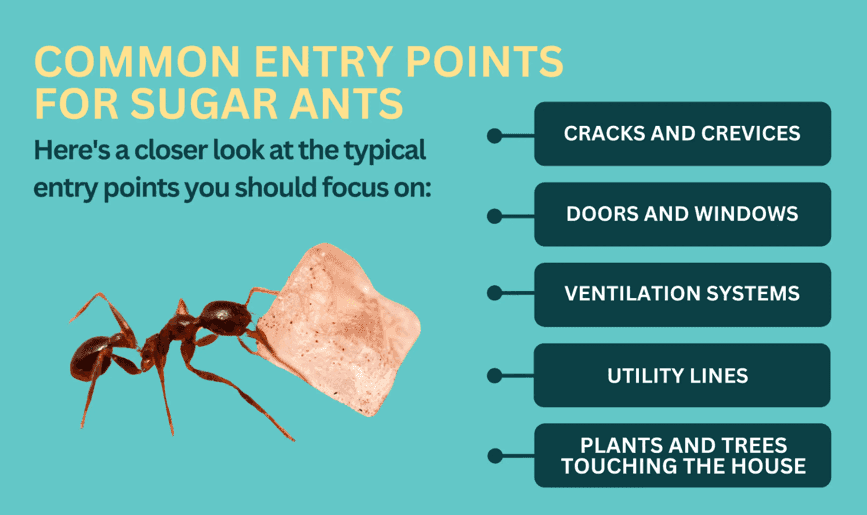How Sugar Ants Are Getting Inside Your South Florida Home
Ever notice a parade of ants on your counter, eyeing your sweets? Sugar ants are tiny home invaders, always on the hunt for sugary snacks.
They sneak in through the smallest gaps—windows, doors, you name it—forming long trails to any sugar spot. Figuring out how they get in is critical to kicking them out.
Ready to stop the march? Let’s dive into keeping those pesky sugar ants at bay.
Key Takeaways
- Sugar ants enter homes through small openings, such as cracks, windows, and utility lines, especially in warm, humid climates like South Florida.
- Sweet foods, protein, fats, moisture, and honeydew attract them inside, leading them to infest areas with accessible food sources and water.
- Signs of a sugar ant infestation include live ants, ant pathways, nests, and infested sugary substances, which indicate an established presence.
- Effective ant control involves sealing entry points, maintaining cleanliness, using natural remedies or chemical baits, and, if persistent problems persist, seeking professional pest control services.
Common Entry Points for Sugar Ants

In South Florida's warm and humid climate, sugar ants find the perfect conditions to thrive and often seek refuge inside homes.
They are resourceful creatures that exploit various small openings in homes. As homeowners, here's a closer look at the typical entry points you should focus on:
Cracks and Crevices
Sugar ants often enter homes through tiny cracks and crevices in the foundation, walls, or around windows and doors. These small openings provide direct access from the outside.
Doors and Windows
Sugar ants commonly enter through improperly sealed doors and windows. These tiny invaders can easily exploit gaps under doors or around window frames.
Ventilation Systems
Ants can enter through ventilation systems, including air conditioning units, exhaust fans, and dryer vents that lead outside.
Utility Lines
Utility lines, such as electrical wires and plumbing, can act as highways for sugar ants to travel into your home. Ants follow these lines through small openings where utilities enter the house.
Plants and Trees Touching the House
Branches or shrubs that touch your home can provide a bridge for sugar ants to enter. They use these natural pathways to bypass ground barriers and access your home’s exterior.
Why Sugar Ants Are Attracted to Your Home
Ants communicate and navigate using pheromone trails, which are scent trails that are invisible to the naked eye.
These trails can lead sugar ants straight into your home because of the following:
Attractants | Details |
Sweet Foods | Sugar ants are naturally drawn to sweet substances in a home. They zero in on spills of soft drinks or remnants of sweet foods left on countertops. |
Easy Access to Food Sources | You may have unknowingly invited ants indoors. Open packages and improperly sealed foods provide a banquet for these tiny critters. |
Proteins and Fats | Sugary foods are not the only ones that attract ants; proteins and fats in pet food or cooking remnants also attract certain ant species. |
Moisture | Ants require moisture for survival. Leaky pipes and water build-up create an ideal environment for ant species. |
Honeydew | Some ants are attracted to honeydew produced by aphids on plants, which can lead ants to venture inside homes when outdoor sources become scarce. |
Preventative Measures to Keep Ants Out
Preventative actions can significantly obstruct sugar ants from entering a home.
Employing Routine Home Maintenance
Here's how routine maintenance tasks can play a crucial role in preventing pest invasions:
Action Step | Details |
Seal Cracks and Holes | Regularly check the exterior of your house for any tiny cracks or holes and seal it with caulk. |
Protect Window and Door | Ensure that window screens and door sweeps are intact and in good condition. |
Trim Vegetation | Look for branches and shrubbery that may be touching the house. |
Maintain Gutter | Check gutters and downspouts for the buildup of plant debris. |
Control Moisture | Repair leaks and ensure proper drainage to discourage ants attracted to damp environments. |
Manage Landscape and Mulch | Assess the use of mulch and other landscaping materials near your home’s foundation. |
Creating an Unwelcoming Environment
To effectively prevent sugar ants from invading your space, consider these strategies for making your home less inviting to them:
Aspect | Details |
Kitchen Cleanliness | Wipe down surfaces regularly to remove any food residue that could attract ants. |
Food Storage | Keep sweet items like soft drinks in airtight containers or refrigerate them to prevent attracting ants. |
Garbage Management | Use bins with tight-fitting lids to keep food aromas from attracting ants. |
Plant Care | Check for aphid infestations since aphids produce honeydew, a known attractant for ants. |
Pet Area Cleanliness | Ensure no leftover food or spills could serve as a food source for ants. |
Should You Seek the Ant Experts?
When dealing with a sugar ant infestation, you might wonder if you should call in professional pest control companies (like us at Native Pest Management).
Sugar ants can be persistent, and while some DIY methods may provide temporary relief, they often return in full force.
This is where a pest control professional comes in handy.
- Expertise: They understand ant behavior more profoundly and can identify the specific species invading your home.
- Efficiency: Professionals can access more effective treatments that may not be available over the counter.
- Time-Saving: They can often resolve infestations faster than DIY efforts, letting you focus on other tasks.
